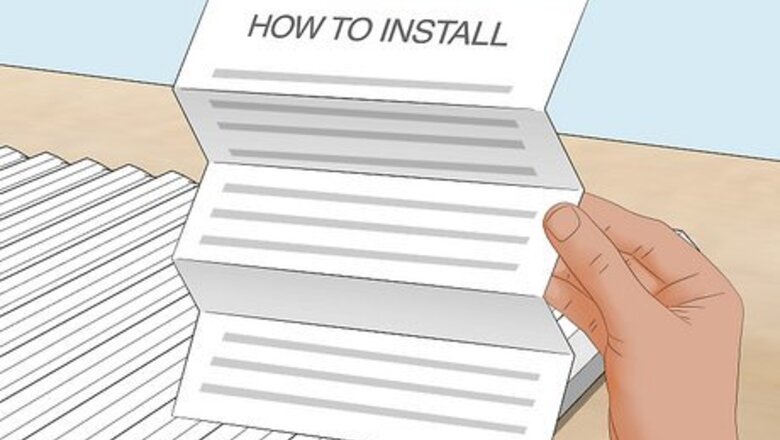
views
- Install your blinds by driving pilot holes for the brackets, screwing them in, and then sliding the blinds into place.
- Measure carefully before ordering your blinds by checking the width and height of multiple points in each window. Use the narrowest width you can find, and the tallest height.
- Choose the type of blinds you want based on how much you want them to stand out in your room.
Assembling and Installing the Blinds
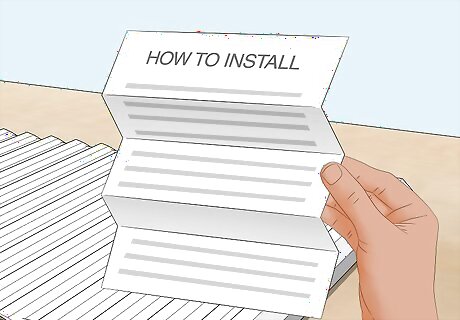
Read the instructions that came with your blinds. The vast majority of blinds are installed the exact same way—you drill brackets into the window frame and then you slide the top of the blind into the hardware before closing it. However, your blinds may have unique adjustments you’ll need to make before installation can take place. Read the instructions thoroughly to understand what you’re doing. To install blinds, you will need a drill, pilot bits that are slightly smaller than the screws that came with your blinds, and a ladder. If you’re installing outside mount blinds (which are above the window, not inside of the frame), you’ll need a level. You won’t need to construct your blinds. They’ll arrive preconstructed and ready for installation. This process is identical for cellular shades, roller blinds, shades, mini-blinds, and vertical blinds.
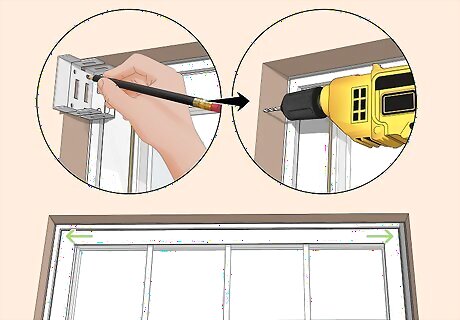
Drill pilot holes for the two brackets that come with your blinds. Pick a window to start with. Take the bracket that opens to the right and hold it up against the top left of the inside of the window frame. Attach a pilot bit slightly smaller than your screws to your drill. Then, drill pilot bits through the openings for the screws in the bracket. Repeat this process for the bracket on the right. You can either hold the bracket still with one hand while you drill with the other, or use a pencil to mark the location of each pilot hole. If your window is especially wide, you may need to drill pilot holes for a center bracket to support the weight. Use a measuring tape to find the center of the frame before you drill! This is for an inside mount. For an outside mount, drive pilot holes into the drywall above the window frame. Use a level to ensure both brackets are even.

Screw the brackets into place with the hardware that came with them. Remove the pilot bit from your drill and put the Phillips screw bit back on. Hold the lefthand bracket in place and drill the screws into the pilot holes you’ve made. Drill each screw in as far as it will go to fully secure the bracket in place. Repeat this process on the opposite side of the frame. Most blinds come with 2-4 screws for each bracket. Use as many screws as you can for the most secure fit. If you have a bracket for the middle of your blinds and you’re adding it to support the weight of an especially long window blind, install that as well.

Slide the top of the blind into the bracket. With both brackets installed, lift the blind up to the top of your window and slide the bulky, top railing of the blind inside of both brackets. Close the bracket by folding the top tab of the bracket down, or by sliding the separate cover piece into the bracket. This will pin the blind inside of the window frame. How each blind bracket is closed differs from style to style, but there are two general categories of closure. The first is a folding hinge on top of the bracket that slides over the top. The other is a separate piece that usually slides into the bracket to close it.
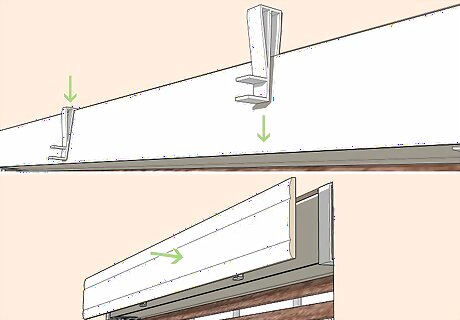
Attach the valence to the top rail of the blind (optional). If you have higher end blinds, you likely have a valence—which is a cover that goes over the top railing of your blinds to cover the brackets. Refer to your blinds directions to determine how to install the valence. Typically, you attach 2-3 clips to the top railing of the blinds and then slide the valence over it. You may need to slide the wand over a small hook to attach the part of your blinds you rotate to open or close them. Once your valence is attached, you’re all good to go! Continue to install the remainder of your blinds the same way you installed the first one.
Measuring and Ordering the Blinds
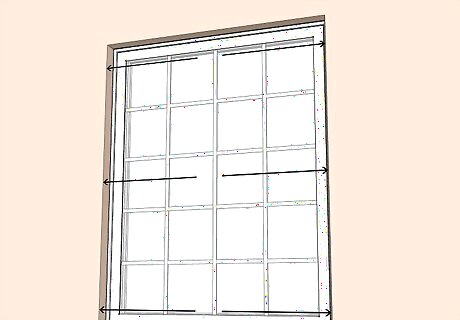
Measure the top, middle, and bottom horizontally. Grab a notebook, a pencil or pen, and a measuring tape. Starting at the very top of the window frame, write down the length. Then, measure the length of the window in the middle. Finish by measuring the very bottom and jot all of these numbers down. Windows—as we’re sure you’re about to find out—are not perfectly even at each point. Unless the home is brand new, the wood frame will have expanded and contracted over the years, leaving it uneven and asymmetrical. For each window you’re measuring, you will take a total of 6 measurements. This process is for inside mounted blinds. For outside mounted blinds, measure the width of the entire window above the trim (on the drywall), down to whatever height you want the blind to go to (normally the bottom of the window frame).

Measure the left, middle, and right vertically. Use your measuring tape to measure the height of the window on the leftmost vertical edge of the window frame. Then, measure the middle of the window from the top to the bottom. Finish by writing down the vertical height of the window frame on the right side.

Use the longest length and the shortest width for each window. You now have two sets of numbers—3 lengths and 3 heights. Take the longest height and use that measurement for your blind’s height. For the length, use the smallest measurement you’ve taken. Blind manufacturers automatically remove a little bit of material from whatever measurements you submit to ensure the entire blind fits, so don’t make subtractions!

Order your blinds from a manufacturer. Go online and look for a blinds manufacturer with pricing and options that suits you. The larger blinds manufacturers are all very high quality, so it’s hard to go wrong if you’re buying from a bigger name. Well-known companies for window treatments include Blinds.com, Blindster, The Shade Store, Lowes, and Home Depot. Some blinds manufacturers will even send you free samples of slat and shade textures if you aren’t sure about what you’re ordering! You can go to your local home improvement store and sort through their in-store stock, but they’re very unlikely to have the specific measurements you need for your windows. You’re almost always better off ordering the blinds.
Choosing a Type of Blind
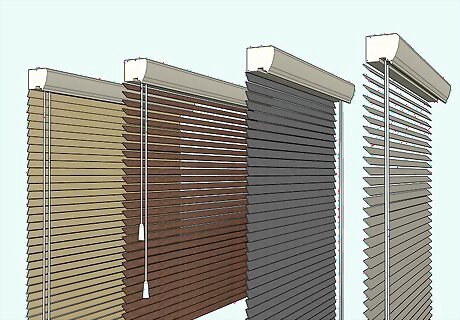
Material: vinyl, faux wood, or wood Blinds can be expensive, but vinyl blinds tend to be very cheap if you’re on a budget. They do have a metal-ish, plastic quality that a lot of people don’t like, though. Real wood tends to feel very high-end. It’s stiff, and has a weight to it that tends to look good. Faux wood offers the best of both worlds—it’s a little cheaper than real wood without feeling quite as cheap as vinyl. Expect to spend $15-30 per vinyl blind depending on the size. Faux wood can range anywhere from $30-120, while real wood tends to be slightly pricier than faux wood (but not dramatically so). For a whole home, you may be spending anywhere from $300 to $3,000 depending on how many windows you have and what material you choose.
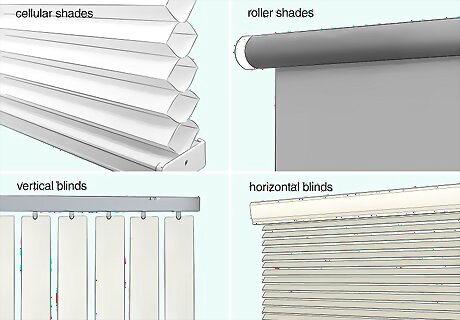
Style: cellular shades, roller shades, vertical blinds, horizontal blinds There are a variety of different styles when it comes to blinds. While all of these blinds will perform the same job—they let light in or cover it up—they have different aesthetic impacts on your space. Your options are: Cellular shades. Also known as honeycomb shades, these shades are pleated layers of fabric that help insulate the window and absorb sound. They tend to do well in modern spaces. Roller shades. Roller shades are single layers of fabric, cloth, or thick paper which rolls up into a bundle when you pull a chain. These shades are super slick and tend to work in modern spaces. Vertical blinds. These old school blinds have vertical slats instead of horizontal slats. These blinds tend to do well in more vintage spaces. Horizontal/Venetian blinds. This is what most people mean when they say “blinds.” Horizontal, aka Venetian blinds contain horizontal slats that slide up and down when you raise the window. These blinds will work anywhere.
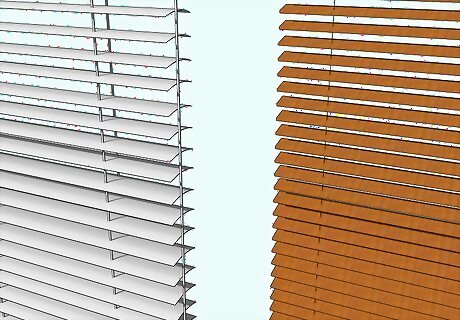
Size: ⁄2–2 in (1.3–5.1 cm) slats The thinner your slats are, the smaller the blinds will look in your window. However, larger slats tend to be considered “classier” and more elegant. Choose the width of your slat based on how noticeable you want the blinds to be and how big your window frames are. Bigger 2 in (5.1 cm) blinds will stand out and make a much larger statement than smaller ⁄2 in (1.3 cm) blinds. ⁄2 in (1.3 cm) blinds are probably ideal if you want to minimize how noticeable the blinds are or your room is very small. The size of your window may limit you here. If the frame on the inside of your window is only 1 in (2.5 cm) wide, you have to use 1 in (2.5 cm) blinds or smaller.
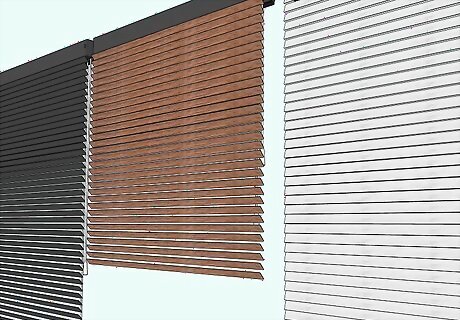
Color: white, black, or wood Blinds typically come in 3 different colors—white, black, or wood/brown. White blinds tend to make a room brighter and warmer feeling, while black blinds are trendier and stand out a bit more. Wood/brown blinds tend to be a little more rustic and old school. There are more unique colors out there if it’s something you’re really interested in, but it can be tough to make non-neutral blinds work. Blackout blinds and shades are almost always black. They’ll completely block out light to keep the room as dark as possible.
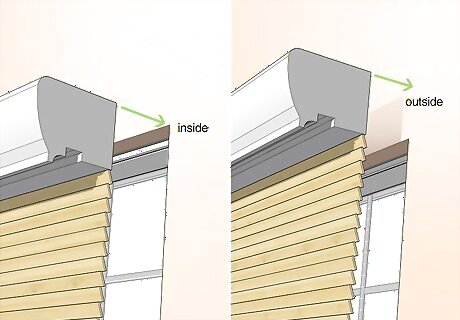
Mounting: inside vs outside Inside mounted blinds go on the inside of the window frame so that the trim of the window is entirely visible. Outside mounted blinds are installed on the drywall above the window frame so the trim at the top is covered when the blinds are down. Most blinds can be installed either with an inside or outside mount. However, measuring for each type of blind is slightly different. Inside mounted blinds are exponentially more popular than outside mounted blinds. The reason is that outside mounted blinds “hide” the window entirely, which can be less attractive. They also tend to make the room feel smaller. Still, they’re an interesting choice if you have some beautiful blinds and the room is very large!




















Comments
0 comment